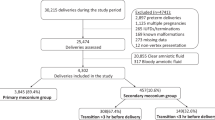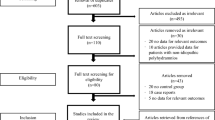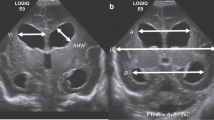Abstract
OBJECTIVE: To ascertain if a dye-determined amniotic fluid volume was predictive of intrapartum and perinatal outcome.
MATERIALS AND METHODS: The low and normal amniotic fluid volumes (<5th percentile and ≥5th percentile for gestational age) and the raw dye-determined amniotic fluid distributions were correlated with 10 clinical outcome measures in 74 pregnancies.
RESULTS: In this observational study, median gestational age at delivery was 36 weeks (range 26 to 41) and 16 deliveries were for fetal distress (14 Cesarean and two forceps). There were no differences between the outcomes of pregnancies with low and normal amniotic fluid volumes for any of the clinical outcomes (variable decelerations influencing delivery, p=0.381; late decelerations, p=0.875; Cesarean births for fetal intolerance of labor, p=0.259; intrauterine growth restriction, p=0.998; or umbilical cord arterial pH<7.2, p=0.259). Analogous results were obtained when the gestational age-adjusted amniotic fluid volumes were compared directly between the pregnancies with normal and abnormal outcomes. There was no difference between the mean amniotic fluid volumes in those pregnancies with variable decelerations influencing delivery (p=0.287), late decelerations (p=0.555), Cesarean births for fetal intolerance of labor (p=0.310), intrauterine growth restriction (p=0.267) or umbilical cord arterial pH<7.2, and the pregnancies without these intrapartum events. Reduced variability was more commonly observed in pregnancies with higher amniotic fluid volumes (p=0.038, 771 ml, 95% CI 468 to 1269, compared to those without normal variability 444 ml, 95% CI 374 to 526).
CONCLUSIONS: Dye-determined amniotic fluid volume does not appear to be predictive of adverse intrapartum and neonatal outcome.
This is a preview of subscription content, access via your institution
Access options
Subscribe to this journal
Receive 12 print issues and online access
$259.00 per year
only $21.58 per issue
Buy this article
- Purchase on Springer Link
- Instant access to full article PDF
Prices may be subject to local taxes which are calculated during checkout
Similar content being viewed by others
References
Rutherford SE, Phelan JP, Smith CV, Jacobs N . The four-quadrant assessment of amniotic fluid volume: an adjunct to antepartum fetal heart rate testing. Obstet Gynecol 1987;70:353–356.
Chamberlain PF, Manning FA, Morrison I, Lange CR, Lange IR . Ultrasound evaluation of amniotic fluid volume I. The relationship of marginal and decreased amniotic fluid volumes to perinatal outcomes. Am J Obstet Gynecol 1984;150:245–249.
Magann EF, Nolan TE, Hess LW, Martin RW, Whitworth NS, Morrison JC . Measurement of amniotic fluid volume: accuracy of ultrasonography techniques. Am J Obstet Gynecol 1992;167:1533–1537.
Magann EF, Morton ML, Nolan TE, Martin Jr JN, Whitworth NS, Morrison JC . Comparative efficacy of two sonographic measurements for the detection of aberrations in the amniotic fluid volume and the effect of amniotic fluid volume on pregnancy outcome. Obstet Gynecol 1994;83:959–963.
Dildy GA, Lira N, Moise KJ . Amniotic fluid assessment: comparison of ultrasonographic estimates versus direct measurements with a dye-dilution technique in human pregnancy. Am J Obstet Gynecol 1992;167:986.
Horsager R, Lathan L, Leveno KJ, Riddle GD, Deter RL . Correlation of measured amniotic fluid volume and sonographic predictions of oligohydramnios. Obstet Gynecol 1994;83:955–958.
Magann EF, Whitworth NS, Rhodes PG, Bass JD, Chauhan SP, Morrison JC . Effect of amniotic fluid volume on neonatal outcome in diamniotic twin pregnancies. South Med J 1998;91:942–945.
Magann EF, Chauhan SP, Martin Jr JN . Is amniotic fluid volume status predictive of fetal acidosis at delivery? Aust NZ J Obstet Gynecol 2003;43:129–133.
Brace RA, Wolf EJ . Normal amniotic fluid volume changes throughout pregnancy. Am J Obstet Gynecol 1989;161:382–388.
Magann EF, Bass D, Chauhan SP, Young RA, Whitworth NS, Morrison JC . Amniotic fluid volume changes in normal singleton pregnancies. Obstet Gynecol 1997;90:5524–5528.
Magann EF, Whitworth NS, Terrone DA, Chauhan SP, Morrison JC . Dye-dilution techniques using aminohippurate sodium: do they accurately reflect amniotic fluid volume. J Matern Fetal Neonatal Med 2002;11:167–170.
Charles E, Jacoby HE . Preliminary data on the use of sodium aminohippurate to determine amniotic fluid volume. Am J Obstet Gynecol 1966;95:266–269.
S-plus Professional edition for Windows Networks. Seattle, Washington: StatSci Division; 2000.
LogXact 5: Logistic regression Software Featuring Exact Methods. Cytel Software Corporation, Cambridge, MA; 2002.
Sarno Jr AP, Ahn MO, Phelan JP . Intrapartum amniotic fluid volume at term. Association of ruptured membranes, oligohydramnios, and increased fetal risk. J Reprod Med 1990;35:719–723.
Author information
Authors and Affiliations
Additional information
Supported in part by Vicksburg Hospital Medical Foundation, Vicksburg, Mississippi
Rights and permissions
About this article
Cite this article
Magann, E., Doherty, D., Chauhan, S. et al. Dye-Determined Amniotic Fluid Volume and Intrapartum/Neonatal Outcome. J Perinatol 24, 423–428 (2004). https://doi.org/10.1038/sj.jp.7211122
Published:
Issue Date:
DOI: https://doi.org/10.1038/sj.jp.7211122



